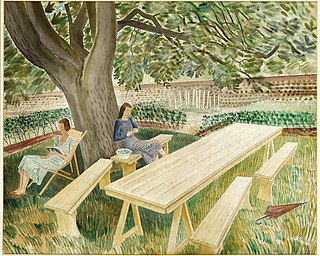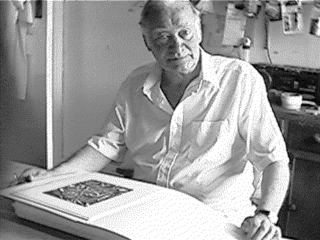Related Research Articles

George John Pinwell, was a British illustrator and watercolourist.
Gwendolen Mary "Gwen" Raverat, was an English wood engraver who was a founder member of the Society of Wood Engravers. Her memoir Period Piece was published in 1952.

Wood engraving is a printmaking technique, in which an artist works an image into a block of wood. Functionally a variety of woodcut, it uses relief printing, where the artist applies ink to the face of the block and prints using relatively low pressure. By contrast, ordinary engraving, like etching, uses a metal plate for the matrix, and is printed by the intaglio method, where the ink fills the valleys, the removed areas. As a result, the blocks for wood engravings deteriorate less quickly than the copper plates of engravings, and have a distinctive white-on-black character.

Eric William Ravilious was a British painter, designer, book illustrator and wood-engraver. He grew up in Sussex, and is particularly known for his watercolours of the South Downs, Castle Hedingham and other English landscapes, which examine English landscape and vernacular art with an off-kilter, modernist sensibility and clarity. He served as a war artist, and was the first British war artist to die on active service in World War II when the aircraft he was in was lost off Iceland.

The Society of Wood Engravers (SWE) is a UK-based artists’ exhibiting society, formed in 1920, one of its founder-members being Eric Gill. It was originally restricted to artist-engravers printing with oil-based inks in a press, distinct from the separate discipline of woodcuts. Today, its support extends to other forms of relief printmaking, and awards honorary membership to collectors and enthusiasts.

Moses Harris was an English entomologist and engraver.
Robert John Gibbings was an Irish artist and author who was most noted for his work as a wood engraver and sculptor, and for his books on travel and natural history. Along with Noel Rooke he was one of the founder members of the Society of Wood Engravers in 1920, and was a major influence in the revival of wood engraving in the twentieth century.

Thomas Hearne was an English landscape painter, engraver and illustrator. Hearne's watercolours were typified by applying a wash of subtle subdued colours over a clear outline in fine brush, pen or pencil. His techniques were studied by younger artists such as Thomas Girtin and J. M. W. Turner.
Henry Eric Bergman (1893–1958), born Heinrich Erich Bergmann, was a Canadian artist born in Dresden, Germany. Bergman’s training was as a commercial wood engraver illustrating catalogs and business prospectuses. He later took up fine art working in pencil, watercolour, oil paint, colour wood block printing but he is best known for his fine black and white wood engravings. Bergman was close friends with Harold R. Foster who created the comic strip Prince Valiant, and appeared on the Hal Foster episode of This Is Your Life in 1954.
Noel Rooke (1881–1953) was a British wood-engraver and artist. His ideas and teaching made a major contribution to the revival of British wood-engraving in the twentieth century.

Vivien Massie Gribble Doyle-Jones was an English wood engraver who was active at the beginning of the 20th century. She was a pupil of Noel Rooke at the Central School of Arts and Crafts and exhibited regularly with the Society of Wood Engravers.
Margaret Pilkington was a British wood-engraver who was active at the beginning of the twentieth century. She was a pupil of Noel Rooke at the Central School of Art and Design and was a member of the Society of Wood Engravers and the Red Rose Guild. She was awarded the OBE in 1956.
E. M. O'R. Dickey was a wood engraver who was active at the beginning of the twentieth century. He was a founder member of the Society of Wood Engravers.
Philip Hagreen was a wood engraver who was active at the beginning of the twentieth century. He was a founder member of the Society of Wood Engravers. He was closely associated with Eric Gill and was a member of the Guild of St Joseph and St Dominic at Ditchling.
Sydney Lee was a British wood engraver, active at the beginning of the twentieth century. He was a founder member of the Society of Wood Engravers (1920). He was also a painter in oils and a Royal Academician.

Joseph John Jenkins was a British engraver and watercolor painter. He is best known for his portraits and landscapes paintings.
Leonard Beaumont (1891–1986) was an English printmaker, graphic designer, illustrator and publisher. He was one of the earliest exponents of the new art of linocut printmaking in Britain during the early 1930s. He was one of a small group of progressive and highly regarded printmakers who exhibited at the Redfern and Ward Galleries in central London. Whilst working in relative isolation in Yorkshire, most of his contemporaries were linked in some way to the Grosvenor School of Modern Art, located in Pimlico, London.
Thomas Heaphy the Elder (1775–1835) was a British watercolourist, known also for his portraits.
Joy Claire Allison Dalby is a British painter, engraver and book illustrator who mainly depicts botanical subjects through watercolour, gouache and wood.

James Bostock was a British painter. His work was part of the painting event in the art competition at the 1948 Summer Olympics.
References
- ↑ Joanna Selborne, ‘The Society of Wood Engravers: the early years’ in Craft History 1 (1988), published by Combined Arts.
- 1 2 3 4 Hilary Chapman, Ethelbert White (1891-1972): Painter, Printmaker (Bicester, Primrose Hill Press, 2003), ISBN 1-901648-34-6.
- ↑ B. T. Jackson, 'The Beaumont Press' in Private Library (Spring 1975), published by the Private Libraries Association.
- ↑ Thomas Balston, 'The wood-engravings of Ethelbert White' in Image 3 (Winter 1949-50).
- 1 2 Peyton Skipwith, Ethelbert White (1891-1972): a Memorial Exhibition (London, Fine Art Society, 1979).
- 1 2 Hilary Chapman, Ethelbert White's Wood Engravings (Netherton, Fleece Press, 1992), ISBN 0-948375-31-0.